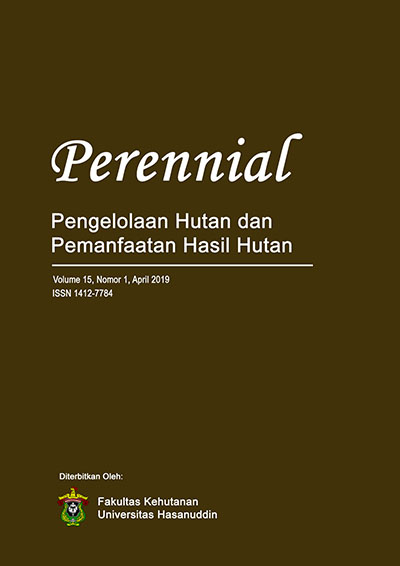KERAGAMAN JAMUR PADA LOG DAN KAYU GERGAJIAN NYATOH (Palaquium sp)
DOI:
https://doi.org/10.24259/perennial.v15i1.6729Keywords:
Diversity, fungi, Palaquium spAbstract
Wood is one medium that can be a place to grow fungus. The chemical components forming wood in the form of holocellulose and lignin which can be overhauled by fungi into simple compounds are a food source for the fungus. This study aims to identify the type of fungus that grows on the log and or sawn wood of Palaquium sp so that it can provide information about the diversity of fungal species, both useful and those that are pathogenic. The process of identifying mushrooms is done by observing the macroscopic and microscopic characteristics of the fungus. The macroscopic characteristics observed were mushroom color and mushroom fruit body shape. Observations of microscopic features include hyphae, spores, sporangium, conidia, and conidiophores. Macroscopic and microscopic observations identified eight types of fungi that grow on real wood, namely Dacryopinax spathularia, Pycnoporus sanguineus, Schizophyllum commune, Cunninghamella echinulata, Penicillium, Trichoderma, Absidia ramosa and Aspergillus. There are six types of fungi which are wood rot fungi, namely D. spathularia; P. sanguineus; S. commune; Penicillium, Trichoderma, and Aspergillus. The other two types are coloring fungi, namely C. echinulata and A. ramosa.References
Aini, N. (2005). Perlindungan Investasi Konstruksi terhadap Serangan Organisme Perusak. Bandung, Indonesia: Pusat Penelitian dan Pengembangan Pemukiman, Badan Penelitian dan Pengembangan Departemen Pekerjaan Umum.
Ballings, P. (2006). Dacryopinax spathularia. Diperoleh dari http:// www.vumbanature.com/Dacryopinax%20spathularia.htm
Barnett, H.L., & Hunter, B.B. (1980). Illustrated Genera of Imperfect Fungi. St. Paul, Minnesota: The American Phytopathological Society.
Berkhout. (1923). Absidia Species. Diperoleh dari https://drfungus.org/knowledge-base/absidia-species/.
Dasanayak, P.N., & Wijeyaratne, S.C. (2017). Cultivation of Schizophyllum commune mushroom on different wood substrates. Journal of Tropical Forestry and Environment, Vol. 07(1): 65-73.
Fassatiova, O. (1986). Moulds and Filamentous Fungi in Technical Microbiology (Progress in Industrial Microbiology; V. 22). Cshechoslavakia, Czech: Elsevier Science Ltd.
Fisher, F., & Norman, C. (1998). Fundamentals of Diagnostic Micologi. Philadelphia, US: W.B. Saunders Company
Gandjar, I., Sjamsuridzal W., & Oetari A. (2006). Mikologi: Dasar dan Terapan. Jakarta: Yayasan Obor Indonesia.
Handajani, N.S, & Setyaningsih, R. (2006). Identifikasi Jamur dan Deteksi Aflatoksin B1 Terhadap Petis Udang Komersial. Biodiversitas, Vol. 7(3): 212-215.
Imamura, Y. (2001). High-Performance Utilization of Wood for Outdoors Uses. Japan: Institute of Wood Technology, Akita Prefectural University.
Isroi. (2008). Isolasi Jamur Makro. Diperoleh dari http://isroi.wordpress. com/2008/02/25/ Isolasi-jamur-makro /#more-50.
Keanekaragaman Hayati [KEHATI]. (2000). Jamur Makroskopis (Cendawan) di TNKS, Small Research 1999/2000. Sumatera Selatan: Dirjen PHKA Departemen Kehutanan dan Yayasan Keanekaragaman Hayati.
Kollman, F.F.P. (1968). Principles of Wood Science and Technology. Solid Wood, Vol. 1. New York: Spring Ervering Berlin Heidelberg.
Kraus, G.F., Druzhinina, I., Gams, W., Bissett, J., Zafari, D., Szakacs, G., Koptchinski, A., Prillinger, H., Zare, R., & Kubicek, C.P. (2004). Trichoderma brevicompactum sp. nov. Mycologia, 96(5): 1059-1073.
Lemaster, R.L, Beal, F.C., & Lewis, V.R. (1997). Detection of Termite with Acoustic Emmission. Forest Product Journal., 47(2): 75-79.
Murtihapsari. (2008). Bio-Dekomposisi Kayu Keras. Fakultas MIPA. Mayor Kimia Sekolah Pascasaarjana. Bogor: Institut Pertanian Bogor.
Niken. (2009). Mengenal Lebih Jelas Trichoderma Viride. Diperoleh dari http://ayya.multiply.com/journal.
Rippon, J.W. (1988). Medical Mycology: the pathogenic fungi and the pathogenic actinomycetes. 3rd Edition. Philadelphia,USA: W.B. Saunders Co.
Rogers. 2001. The Mushrooms: Schizophyllum commune. http://www.rogersmooshrooms.com/gallery/DisplayBlock~bid~6764.asp.
Samson, R.A., Visagie, C.M., Houbraken, J., Hong, S.B., Hubka, V., Klaassen, C.H.W., Perrone, G., Seifert, K.A., Susca, A., Tanney, J.B., Varga, J., Kocsube, S., Szigeti, G., Yaguchi, T., & Frisvad, J.C. (2014). Phylogeny, identification and nomenclature of the genus Aspergillus. Studies In Mycology, 78: 141–173. DOI: 10.1016/j.simyco.2014.07.004
Schuster, A., & Schmoll, M. (2010). Biology and biotechnology of Trichoderma. Appl Microbiol Biotechnol (2010) 87:787–799. DOI 10.1007/s00253-010-2632-1.
Setyowati, N., Bustamam, H., & Derita, M. (2003). Penurunan Penyakit Busuk Akar dan Pertumbuhan Gulma pada Tanaman Selada yang Dipupuk Mikroba. Jurnal Ilmu-ilmu Pertanian Indonesia, Vol. 5(2): 48-57.
Singh, K., Frisvad, J.C., Thrane, U., & Mathur, S. B. (1991). An Illustrated Manual on Identification of some Seed-borne Aspergilli, Fusaria, Penicillia and their Mycotoxins. Denmark: Danish Goverment Institute of Seed Pathology for Developing Countries and departement of Biotechnology the Technical University.
Streets, R.B. (1980). Diagnosis Penyakit Tanaman. Alih Bahasa Indonesia oleh Imam Santoso. Jakarta: PT Gede Jaya,
Sutton, D.A. (2007a). Cunninghamella sp. Diperoleh dari http://www.doctorfungus.org/thefungi/Cunninghamella.htm.
Sutton, D.A. (2007b). Trichoderma sp. Diperoleh dari http://www.doctorfungus.org/thefungi/Trichoderma.htm.
Sutton, D.A. (2007c). Absidia sp. Diperoleh dari http://www.doctorfungus.org/thefungi/absidia.htm.
Sutton, D.A. (2007d). Aspergillus sp. Diperoleh dari http://www.doctorfungus.org/thefungi/ Aspergillus_spp.htm.
Tambunan, B., & Nandika D. (1982). Deteriorasi Kayu oleh Faktor Biologis. Bogor: Departemen Hasil Hutan, Fakultas Kehutanan, Institut Pertanian Bogor.
Visagie, C.M., Houbraken, J., Frisvad, J.C., Hong, S.B., Klaassen, C.H.W., Perrone, G., Seifert, K.A., Varga, J., Yaguchi, T., & Samson, R.A. (2014). Identification and nomenclature of the genus Penicillium. Studies In Mycology 78: 343–371. DOI: 10.1016/j.simyco.2014.09.001.
Winkler, D. (2008). Mushroaming Hawaii: Kauai, Hawaii – The Big Island, Oahu. Diperoleh dari http://mushroaming.com/ MushRoaming_Hawaii_2008
Wursten, B. (2009). Pycnoporus sanguineus. Diperoleh dari http://www.vumba-nature.com/Pycnoporus%20sanguineus .htm
Zabel, R.A , & Morrel, J.J. (1992). Wood Michrobiology: Decay and Its Preservation. San Diego: Academic Press, Inc. .


